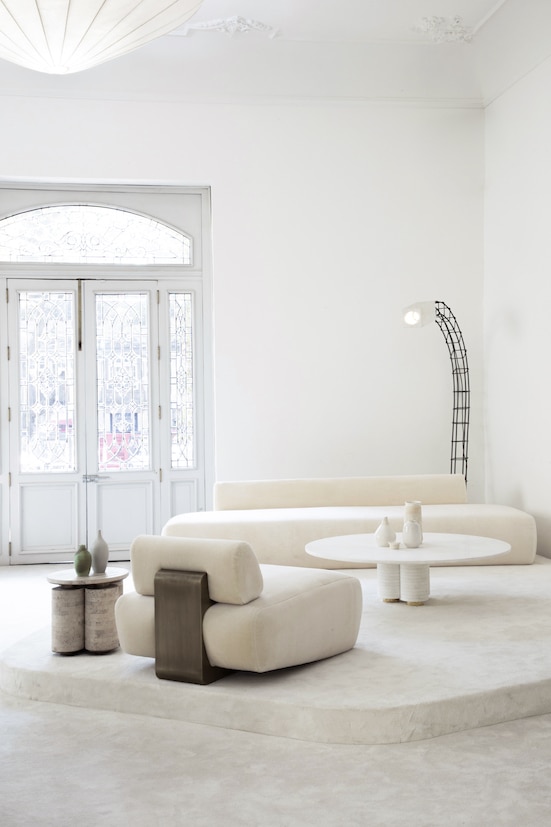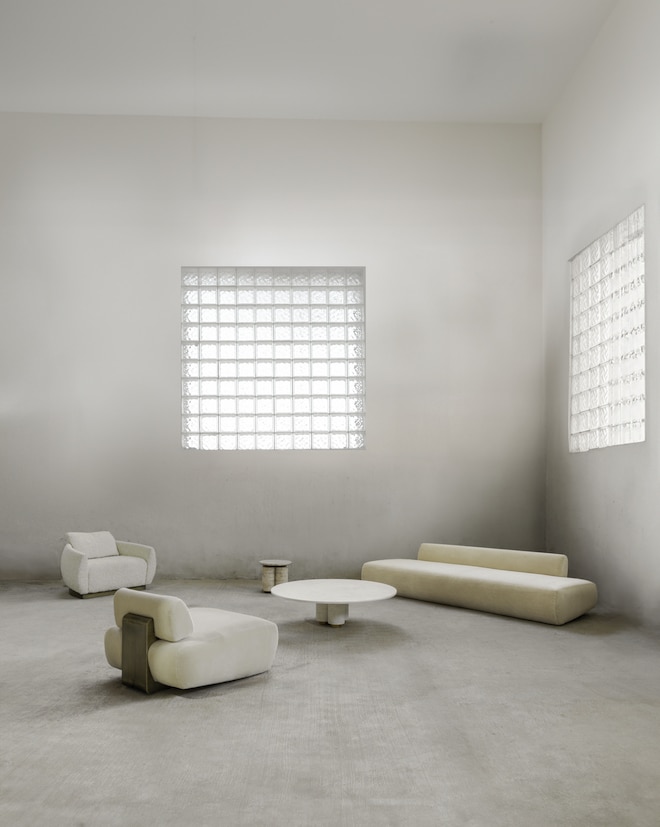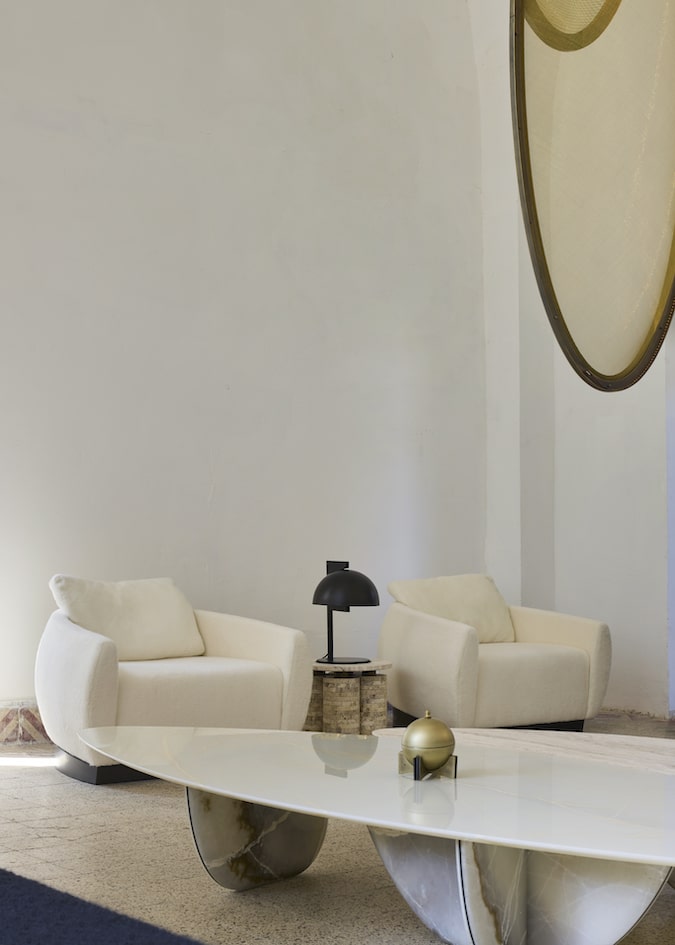
Atra

ATRA founder Alexander Díaz Andersson was raised in Sweden, studied in Spain before moving to the Yucatán peninsula, where he first started experimenting with furniture. Now located in Mexico City and L.A., Díaz Andersson’s furniture, sculptures, interiors, and hospitality projects are defined by a studied balance of chaos and structure, fluidity and function. Trained in industrial design, Díaz Andersson combines academic learning with knowledge passed down from experienced artist mentors and the energy of autodidactic exploration. His practice is both intuitive and informed by an understanding of history, process, and materials. Above all, Díaz Andersson’s guiding principle is pleasure. Alexander Díaz Andersson has been featured in Wallpaper Magazine, Architectural Digest, GQ, Surface, and Vogue to name a few. He was awarded Prix Versailles UNESCO “ best Restaurant 2024″ for ILIS, NYC. Best In Show for his presentation at Design Miami 2021 and is shortlisted in different categories for his upcoming residential projects being released this year.
1. Where were you born and where are you from ?
I was born and grew up in Sweden, studied in Spain, and now live and work in Mexico City. I lived in Mérida for many years, and moving to Mexico City felt like a natural next step. Mexico, along with Sweden, forms a big part of my heritage, and I take pride in both.
2. What is your first memory connected to the art world ?
My parents’ Carl Magnus painting, I couldn’t stop looking at it.
3. Have you always worked in the art/design field, and what led you to the design creation ?
Yes, I’ve always worked in the art and design field. I’ve been a furniture designer for almost 20 years and expanded into architecture over the past six years. My journey began in the Yucatán Peninsula, where I worked in my family’s furniture business. My mother was a consultant for IKEA, helping to establish their upholstery production in Mexico and founding a factory that supplied both IKEA and major hospitality groups. Growing up surrounded by design and production, I developed a natural affinity for the craft. Although I studied industrial design at university in Madrid, much of my learning was self-directed and shaped by mentorship. One of my most influential mentors was Alexander Carlsson, a visionary designer who later became the director of industrial design at SEDIM in Mexico. Around 2008, when my family transitioned out of large-scale production, I set up a small woodworking shop and taught myself carpentry through trial and error. Over time, I became passionate about mastering traditional techniques and pushing the boundaries of design, blending heritage with contemporary innovation.
4. How would you describe your creative process and it influences ?
As time goes on, the concepts behind each collection evolve. The common thread that ties everything together is our commitment to quality and craftsmanship. Conceptually, we’re inspired by utopian ideas of the future. Our goal is to create timeless objects, both in quality and vision. We’ve even imagined a universe—Earth 2100—where our designs exist, and within that world, we tell stories like “future relics,” envisioning how our pieces will be passed down through generations.
5. Could you describe a typical day of your work ?
ATRA has evolved into a multidisciplinary force, bridging creative concepts, biohacking architecture, furniture design, and cultural expressions of art. Every day at ATRA involves coordinating these diverse industries while maintaining a unified thread of conceptual design.
6. Why did you choose the specific materials you work with ?
After Madrid, I moved to Mérida, Yucatán, to dive deeper into traditional craftsmanship—mainly woodworking and upholstery. We even developed an exchange program, bringing Swedish master upholsterers to share their techniques with our artisans. After about four years of research, we defined our design language and launched the ATRA chair collection, which marked our beginning. Over the next 15 years, both the brand and our manufacturing techniques evolved. We expanded from wood and upholstery to stone, metal, and lighting—creating more sculptural pieces along the way.


7. What are the technical particularities of your creations ?
Our creations are distinguished by a harmonious blend of traditional craftsmanship and modern technology. We integrate time-honored techniques with cutting-edge methods such as CNC production, stoneworking, metallurgy, and upholstery.
8. What advices could you give to beginning artists who would like to create sculptural design works ?
Finding your design language takes time, and it’s essential to move beyond references to create something truly original. My advice is to focus on developing a language that is authentically your own, one that reflects your individuality and vision.
9. If your works had to belong to a design movement, in which one would you define it ?
Brutalism is the movement I recognize most in my designs.
10. What designers and artists have influenced you ?
Scarpa, Isamu Noguchi, Buckminster Fuller, and Arne Jacobsen have all influenced me, but my inspiration extends beyond designers. I’m deeply influenced by historical architecture, particularly Egyptian and Aztec. Nature is another profound source of ideas for me; Its forms, shapes, and inherent perfection offer insights that no human design can replicate.
11. What contemporary designers do you appreciate ?
I don’t think too much about contemporary designers, but I do really like Vincenzo De Cotiis
12. What contemporary artists (in any kind of art) have you been inspired by ?
Walter De Maria, Sol LeWitt, James Turrell, Michael Heizer, Paul Fägerskiöld, among many others.
13. If you had to summarize your creations in one word or sentence, what would it be ?
I prefer to allow people to make their own projections
PROUST QUESTIONNAIRE
(The Proust Questionnaire is a set of questions answered by the French writer Marcel Proust.
Other historical figures who have answered confession albums are Oscar Wilde,
Karl Marx, Arthur Conan Doyle, Stéphane Mallarmé, Paul Cézanne…)
1. What is your idea of perfect happiness?
My family’s safety, being connected to nature, and having time.
2. What is your greatest fear?
Being stagnant.
3. What is the trait you most deplore in yourself?
Don’t have deplorable traits, don’t like to have that relationship with my self.
4. What is the trait you most deplore in others?
Mediocrity
5. Which living person do you most admire?
My mother.
6. What is your greatest extravagance?
I’d rather not say.
7. What is your current state of mind?
Calm and focused.
8. What do you consider the most overrated virtue?
Chastity
9. What is the quality you most like in a man ?
Nobility.
10. What is the quality you most like in a woman ?
Kindness and strength.


11. Which words or phrases do you most overuse?
“And that’s that.”
12. Which talent would you most like to have?
To be a space pilot.
13. If you could change one thing about yourself, what would it be?
To stop losing things around the house.
14. What do you consider your greatest achievement?
My future child.
15. If you were to die and come back as a person or a thing, what would it be?
Superman.
16. Where would you most like to live?
In a forest in the mountains near a river, close to the sea, and central enough to easily travel to a city. Somewhere like Northern Italy or Switzerland.
17. What is your most treasured possession?
My company, ATRA.
18. What do you regard as the lowest depth of misery?
Loss of power of self
19. What is your favorite occupation?
Astronaut.
20. What is your most marked characteristic?
I don’t give up.
21. What do you most value in your friends?
Their company.
22. Who are your favorite writers?
Murakami, Kerouac, Hemingway, and many more.
23. Who is your hero of fiction?
Luke Skywalker and the Count of Monte Cristo.
24. Which historical figure do you most identify with?
I don’t really relate to historical figures. It’s very a projective perspective since it’s only based on an idea of someone
25. Who are your heroes in real life?
My parents, my life partner, my family, and my business partner.
26. What are your favorite names?
I like Greek and Nordic god names—not one specific, but generally those types.
27. What is it that you most dislike?
Laziness.
28. What is your greatest regret?
My regrets have become my most important lessons in life.
29. How would you like to die?
Happy.
30. What is your motto?
You only live once.

